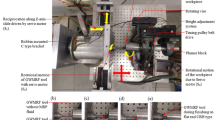Abstract
The magnetorheological honing (MRH) tool is an advanced finishing tool which is designed and developed to superfinish internal cylindrical surfaces. It uses magnetorheological polishing fluid consisting of carbonyl iron particles and cutting-edge silicon carbide abrasives in viscous fluid medium. The MRH tool with retained polishing fluid is rotated and reciprocated inside a cylindrical workpiece within the gap between the outer surface of the MRH tool and the inner surface of the cylindrical workpiece called the working gap. Due to the relative motion between abrasives (gripped by carbonyl iron particles chains) and the workpiece’s inner surface, finishing action takes place over the inner surface of the cylindrical workpiece. In this paper, two different designs of the MRH tool are designed with the same parameters based on finite element (FE) analysis using Ansoft Maxwell. The FE analysis results in more magnitude and uniformity of magnetic flux density in the working gap for the improved design of the MRH tool. Due to this effect, the abrasives are more strongly held with uniform strength which results in comparatively significant uniform finishing of the internal surface of the cylindrical workpiece. After confirmation of higher and uniform magnetic flux density on the improved MRH tool surface from FE analysis, two designs of the MRH tool are then fabricated with the same dimensions as taken in magnetic simulation. Experimentations have been performed with the fabricated finishing tools over the inner surface of cylindrical ferromagnetic workpiece of mild steel. The MRH tool with improved design results in uniform and more reduction in value of surface roughness with the same finishing time and process parameters as compared to the first proposed design. This confirms the enhancement in the finishing capability and better usefulness of the improved design of the MRH tool.
Similar content being viewed by others
References
Jha S, Jain VK (2006) Modeling and simulation of surface roughness in magnetorheological abrasive flow finishing (MRAFF) process. Wear 261:856–866
Grover V, Singh AK (2017) A novel magnetorheological honing process for nano-finishing of variable cylindrical internal surfaces. Material and Manufacturing Processes. https://doi.org/10.1080/10426914.2016.1257801
Wu X, Kita Y, Ikoku K (2007) New polishing technology of freeform surface by GC. J Mater Process Technol 187–188:81–84
Shiou FJ, Chen CH (2003) Freeform surface finish of plastic injection mold by using ball-burnishing process. J Mater Process Technol 140:248–254
Nowicki B (1993) The new method of freeforms surface honing. CIRP Ann Manuf Techn 42:425–428
Cho S, Ryu YK, Lee SY (2002) Curved surface finishing with flexible abrasive tool. Int J Mach Tools Manuf 42:229–236
Shaw MC (1996) Principles of abrasive processing. Clarendon, Oxford
Bedi TS, Singh AK (2016) Magnetorheological methods for nanofinishing—a review. Particul Sci Technol 34(4):412–422
Kordonski WI, Jacobs SD (1996) Magnetorheological finishing. Int J Mod Phys B 10:2857–2865
Das M, Jain VK, Ghoshdastidar PS (2012) Nanofinishing of flat workpiece using rotational-magnetorheological abrasive flow finishing (R-MRAFF) process. Int J Adv Manuf Technol 62:405–420
Jha S, Jain VK (2004) Design and development of the magnetorheological abrasive flow finishing (MRAFF) process. Int J Mach Tools Manuf 44:1019–1029
Singh AK, Jha S, Pandey PM (2011) Design and development of nanofinishing process for 3D surfaces using ball end MR finishing tool. Int J Mach Tools Manuf 51:142–151
Chen M, Liu H, Su Y, Yu B, Fang Z (2016) Design and fabrication of a novel magnetorheological finishing process for small concave surfaces using a ball-end permanent-magnet polishing head. Int J Adv Manuf Technol 83:823–834
Kordonski W, Shorey A (2007) Magnetorheological (MR) jet finishing technology. J Intell Mater Syst Struct 18:1127–1130
Sadiq A, Shunmugam MS (2009) Investigation into magnetorheological abrasive honing (MRAH). Int J Mach Tools Manuf 49:554–560
Wang J, Chen W, Han F (2015) Study on the magnetorheological finishing method for the WEDMed pierced die cavity. Int J Adv Manuf Technol 76:1969–1975
Sidpara A, Jain VK (2012) Experimental investigations into surface roughness and yield stress in magnetorheological fluid based nano-finishing process. Int J Adv Manuf Technol 13(6):855–860
Niranjan MS, Jha S (2015) Experimental investigation into tool aging effect in ball end magnetorheological finishing. Int J Adv Manuf Technol 80:1895–1902
Martínez-Mateo, I. (2011) Surface damage of mould steel and its influence on surface roughness of injection moulded plastic parts. 18th International Conference on Wear of Materials 271: 2512–2516
Gupte PS, Wang Y, Miller W, Barber GC, Yao C, Zhou B, Zou Q (2008) A study of torn and folded metal (TFM) on honed cylinder bore surfaces. Tribol Trans 51:784–789
Jain VK (2008) Abrasive-based nano-finishing techniques: an overview. Mach Sci Technol 12:257–294
Stradling AW (1993) The physics of open-gradient dry magnetic separation. Int J Miner Process 39:19–29
Grover V, Singh AK (2017) Analysis of particles in magnetorheological polishing fluid for finishing of ferromagnetic cylindrical workpiece. Particul Sci Technol. https://doi.org/10.1080/02726351.2017.1302535
Funding
The authors acknowledge the Science and Engineering Research Board, Department of Science and Technology, New Delhi, India, (Project no. EMR/2015/000330) for their financial support.
Author information
Authors and Affiliations
Corresponding author
Rights and permissions
About this article
Cite this article
Grover, V., Singh, A.K. Improved design of magnetorheological honing tool based on finite element analysis and experimental examination of its performance. Int J Adv Manuf Technol 100, 1067–1080 (2019). https://doi.org/10.1007/s00170-017-1149-5
Received:
Accepted:
Published:
Issue Date:
DOI: https://doi.org/10.1007/s00170-017-1149-5



